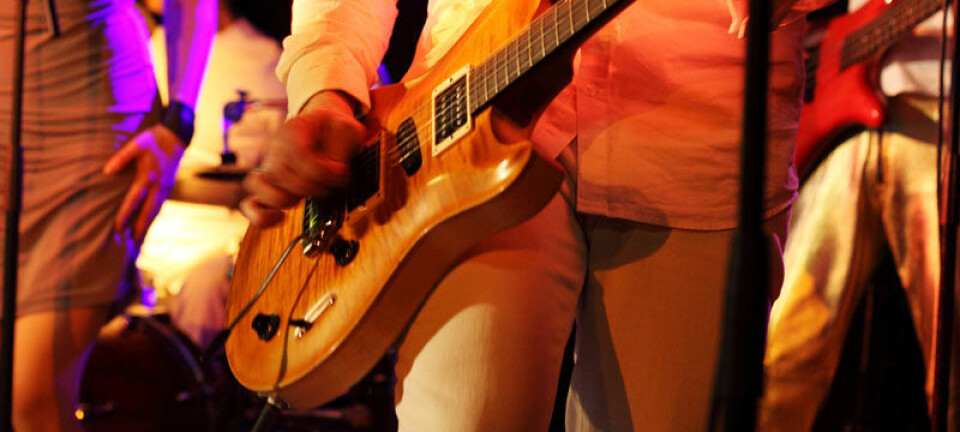This article was produced and financed by University of Stavanger

Music in harmony with faith
There is a clear connection between spiritual beliefs in a society and the music it creates, says Norwegian researcher.
Denne artikkelen er over ti år gammel og kan inneholde utdatert informasjon.
Religious narratives are concerned with origins and destinations, observes Jon Skarpeid, who works in the department of cultural studies and languages at the University of Stavanger (UiS).
The questions they address include where we come from and where we are headed, he notes. But music also has a mystical and existential character.
His doctoral work on religion at the Norwegian University of Science and Technology (NTNU) in Trondheim includes a study of Hindu music.
The latter was developed and cultivated at north Indian royal courts, and Skarpeid relates its compositions to religious beliefs in the wider community.
He first became interested in this subject when he experienced an insight while reading comparative theology.
“I’d chanced on a CD of Indian music and was listening to it while studying Hinduism – and got a surprise,” he recalls. “The music was playing what I was reading. It came across to me as the religion’s world view – its cosmology – in miniature.”
Circular
Skarpeid found that Indian music reflects core beliefs expressed in Hinduism ¬ that there is no beginning and no end, but that all is circular.
The world is created, it is maintained, it is absorbed again. After a pause, a new creative period begins and the same cycle gets repeated.
Having observed the parallels between music and religious beliefs in India, Skarpeid realised that the phenomenon was not confined to a single faith.
“I began to reflect on Beethoven and Bach, and works such as the Fifth Symphony and the Toccata and Fugue in D minor. These have a clear beginning and end – just as Christianity teaches.
“Something’s been created from nothing – creato ex nihilo. We can interpret the start of the music as a creation story in miniature and its conclusion as an expectation of end times.”
But he is not arguing that composers such as Beethoven or Bach said to themselves that they were going to produce something which parallels the great narrative of Christianity.
“While I don’t think they were doing this consciously, however, they were breathing in their Christian culture,” he points out.
“Beethoven composed immediately after the French Revolution and must naturally also be understood in the light of that watershed in European history.
“At first, I thought that music was imitating the culture. But my view has since changed – music isn’t secondary to religion or philosophy, but simply another mode of expression.”
Skarpeid nevertheless observes that music – like other aspects of culture – is subject to change, and notes that Islam has exerted a certain influence on Indian music.
The royal courts of northern India were partly Hindu and partly Muslim – a faith which, like Christianity, believes in a day of judgement.
Although not specifically religious, the music played in these settings was influenced by both Hinduism and Islam. Traditions primarily cultivated by Muslims are characterised by a greater degree of finality than those of Hindus.
Change
The western world has also been affected by change, Skarpeid believes. “Although Christianity has lost its former dominance, it influenced key thinkers such as Marx.
“He envisaged a paradisal Communism and a classless society. Other political Utopias were also characterised by optimism for the time to come.
“They represented more or less secular manifestations of a Judaeo-Christian hope for the future, which persisted to a greater or lesser extent until the advent of postmodernism.”
Skarpeid argues that postmodernism and the new orientations in social and intellectual life which followed it ended the hegemony of the great narratives of state and religion.
“So it’s natural that the music of postmodern composers such as Arvo Pärt and Henryk Górecki is characterised by the loss of a marked start and finish.
“There’s less either-or thinking. We used to believe in a clear-cut beginning and end. In place of finality, we have gradual transitions”.
He now sees signs of yet another change. “I detect tendencies in music towards closing strategies marked rather more by finality than in postmodernism – although they can’t be compared in any way with Beethoven or Bach.
“But it’s difficult to research your own times, and it’s not easy to say what this new trend is an expression of. It may relate to the fact that we’re less relativistic and more oriented towards clear views than a few decades ago.
“Whatever the case might be, I’d still emphasise that such insights represent only one way of approaching music.”
Translated by: Rolf E. Gooderham


































